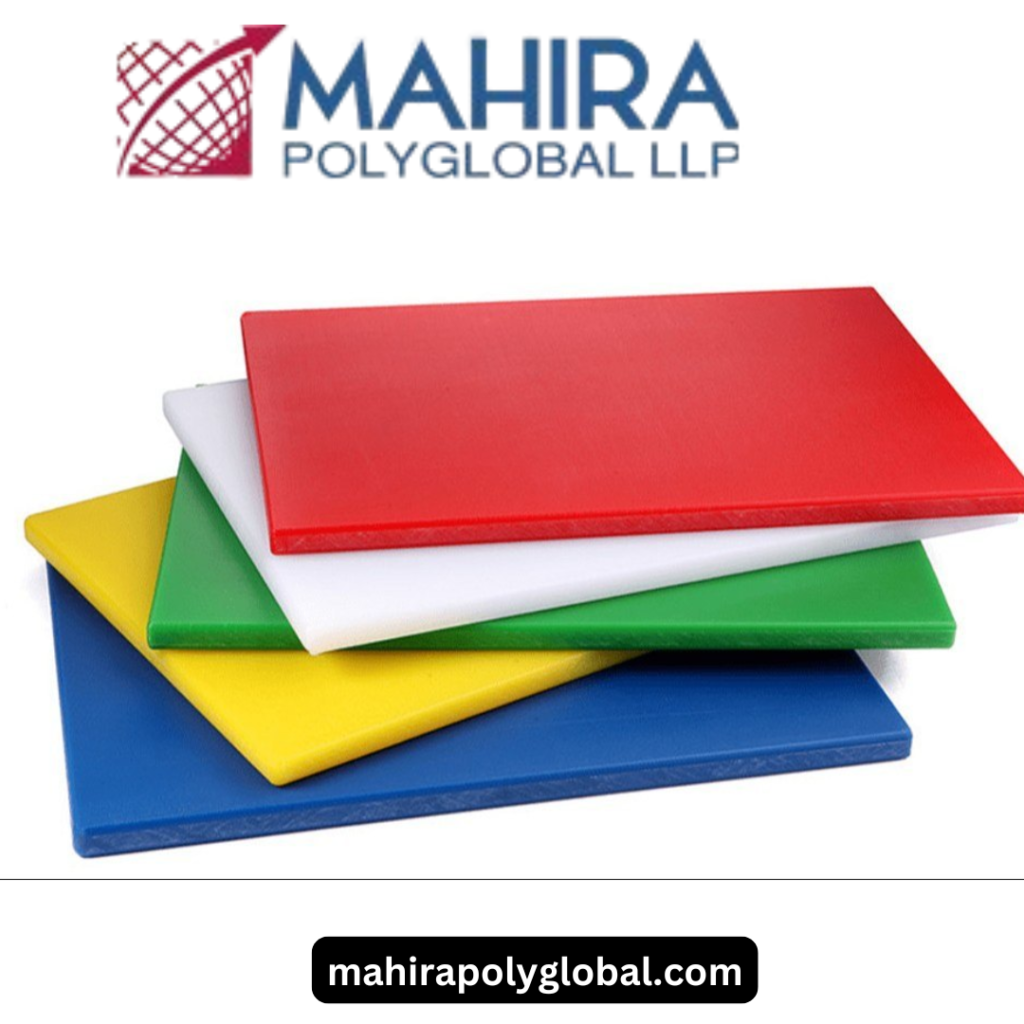High-Density Polyethylene (HDPE) sheets are widely regarded as one of the most durable, versatile, and cost-effective materials in the plastic industry. Known for their robustness and resistance to environmental factors, HDPE plastic sheets are used in a variety of applications, from industrial uses to construction and packaging. This Mahira Polyglobal LLP will explore the properties, uses, pricing, and environmental impact of HDPE sheets, along with answering frequently asked questions about this incredible material.
What Are HDPE Sheets?
High-Density Polyethylene (HDPE) sheets are made from a high-density form of polyethylene, a thermoplastic polymer that is widely used across various industries. The high-density polyethylene sheet is known for its strength, durability, and versatility. It is a type of plastic that is resistant to a wide range of chemicals, moisture, and UV degradation. This makes HDPE sheets perfect for outdoor, industrial, and commercial applications where long-term performance is required.
HDPE sheets are made by compressing high-density polyethylene material into sheets of various thicknesses and sizes. These sheets come in different forms such as matte, smooth, or textured, offering a wide variety of choices for different applications. Available in a range of colors, HDPE sheets can also be custom-cut to fit particular requirements, adding to their adaptability and value.
Key Benefits of Using HDPE Plastic Sheets
The popularity of HDPE plastic sheets can be attributed to their numerous benefits. Some of the key advantages include:
- Strength and Durability: HDPE sheets are known for their exceptional strength, making them suitable for heavy-duty applications. Their resistance to impact, cracking, and abrasion ensures that they can handle high-stress environments with ease.
- Chemical Resistance: HDPE plastic sheets offer excellent resistance to a variety of chemicals, including acids, solvents, and bases. This makes them ideal for applications involving chemical storage or handling, where other materials might degrade over time.
- Moisture and Weather Resistance: HDPE sheets do not absorb moisture, which makes them perfect for environments where exposure to water or humidity is common. They are also resistant to UV radiation, which ensures that they will not degrade when exposed to the sun.
- Low Maintenance: HDPE sheets are extremely low-maintenance. They do not rust, corrode, or require frequent cleaning. Their smooth surface also makes them easy to maintain and sanitize, particularly in industries such as food processing.
- Eco-Friendly: One of the standout features of HDPE sheets is their recyclability. HDPE is a 100% recyclable material, making it an environmentally friendly choice. The recycling process helps reduce the overall environmental impact of plastic waste and encourages a more sustainable future.
Common Applications of HDPE Sheets
HDPE sheets are used in a wide range of industries due to their versatility and durability. Here are some common applications:
- Construction Industry: In construction, HDPE sheets are commonly used as protective barriers, liners for landfills, drainage systems, and waterproof membranes. The material’s resistance to water and chemicals makes it ideal for creating long-lasting, waterproof structures.
- Packaging: HDPE plastic sheets are often used in packaging materials such as containers, bottles, and lids due to their strength and ability to resist chemicals. The material is commonly used for food packaging, as it is safe for food contact and prevents contamination.
- Agriculture: The agricultural industry uses HDPE sheets for a variety of applications, including greenhouse covers, pond liners, and irrigation systems. The material’s ability to withstand UV radiation and harsh chemicals makes it an ideal choice for outdoor applications.
- Signage and Displays: HDPE sheets are also used in the production of durable outdoor signs, display boards, and trade show displays. They are resistant to fading and wear, making them ideal for signage that needs to withstand exposure to the elements.
- Waste Management: HDPE plastic sheets are used in the manufacturing of waste containers, trash bins, and other waste management products. Their ability to resist corrosion and chemicals makes them suitable for long-term exposure to waste materials.
- Transportation: HDPE plastic sheets are widely used in the transportation industry for applications such as truck liners, bumpers, and vehicle parts. Their durability and impact resistance make them ideal for handling rough conditions.
The Cost of HDPE Sheets: What Affects the Price?
The price of HDPE sheets can vary depending on a range of factors, including the thickness, size, color, grade, and customization. Generally, the cost of high-density polyethylene sheets is considered affordable compared to other materials, especially for bulk purchases. However, for specific requirements such as food-grade HDPE or custom designs, the price may be higher.
HDPE sheets are typically sold by the square foot or square meter, and the cost per unit decreases when purchased in larger quantities. For businesses that require bulk orders, negotiating with suppliers can help secure more competitive prices. The grade of HDPE used can also influence the cost; for example, food-grade or chemical-resistant HDPE sheets tend to be more expensive than standard grades.
The complexity of fabrication may also impact the price. Custom cutting, surface texturing, and other modifications can increase the overall cost of the material. However, the long-term durability and low maintenance of HDPE sheets can make them a cost-effective solution for many industries, as they provide significant savings over time by reducing replacement and repair costs.
Comparison of HDPE Sheets with Other Materials
When compared to other materials like PVC, polypropylene, and metals, Polyethylene roll offer several distinct advantages. While PVC is also widely used in construction and industrial applications, HDPE tends to be more durable and resistant to impact and chemicals. PVC can become brittle over time, especially when exposed to UV radiation, while HDPE remains strong and flexible.
Polypropylene, another common material, is known for its excellent chemical resistance. However, HDPE plastic sheets generally offer better resistance to wear, impact, and UV degradation. HDPE is also more cost-effective, making it an attractive option for businesses looking for a budget-friendly yet reliable material.
In comparison to metals, HDPE sheets offer the advantage of being much lighter and more flexible. This makes them easier to handle, fabricate, and install. Additionally, HDPE does not rust or corrode like metals, and its smooth surface is easier to maintain.
Environmental Considerations and Sustainability
HDPE sheets stand out in terms of their environmental benefits. As mentioned earlier, HDPE is 100% recyclable, which helps to reduce plastic waste and conserve natural resources. The material is also non-toxic, meaning it does not leach harmful chemicals into the environment. This makes HDPE a safer choice compared to other plastic materials that may contain toxic additives.
In the construction industry, HDPE sheets are often used as liners for landfills or ponds, where they help to prevent leakage and contamination of surrounding soil and water. The ability to reuse and recycle HDPE sheets also contributes to reducing the need for virgin plastic production, helping to lower the carbon footprint of manufacturing processes.
Furthermore, HDPE’s durability ensures that it will last for a long time, reducing the need for frequent replacements. This means fewer materials need to be produced, resulting in lower environmental impact over time.
Conclusion
The High density polyethylene sheet price are an incredibly versatile and durable material that provides a wide range of benefits for various industries. From construction and agriculture to packaging and waste management, the strength, chemical resistance, and environmental friendliness of HDPE make it an ideal choice for many applications. The affordable price, low maintenance requirements, and recyclability of HDPE plastic sheets further enhance their appeal.
When selecting HDPE sheets for your project, consider factors such as size, thickness, grade, and customization to ensure that you choose the right material for your needs. While the initial price of HDPE plastic sheets may vary depending on specific requirements, their long-term durability and sustainability make them a cost-effective option in the long run.
Frequently Asked Questions (FAQs)
1. How do HDPE sheets compare to PVC sheets in terms of strength and durability?
HDPE sheets generally offer superior strength and durability compared to PVC. HDPE is more resistant to impact, cracking, and UV degradation, making it a better choice for outdoor and heavy-duty applications.
2. Can HDPE sheets be used in food processing?
Yes, HDPE sheets are commonly used in food processing due to their non-toxic properties, resistance to bacteria, and ease of cleaning. Food-grade HDPE sheets are specifically designed for applications involving direct contact with food.
3. Are HDPE sheets environmentally friendly?
HDPE sheets are environmentally friendly as they are 100% recyclable. They also have a long lifespan, which reduces the need for frequent replacements, and they do not leach harmful chemicals into the environment.
4. What is the typical lifespan of HDPE sheets?
HDPE sheets are highly durable and can last for several years, even when exposed to harsh environmental conditions. Their resistance to UV rays, chemicals, and moisture ensures that they remain functional and effective for long periods.







